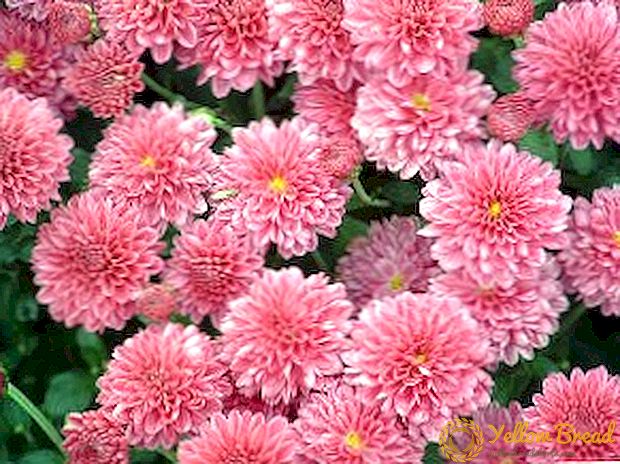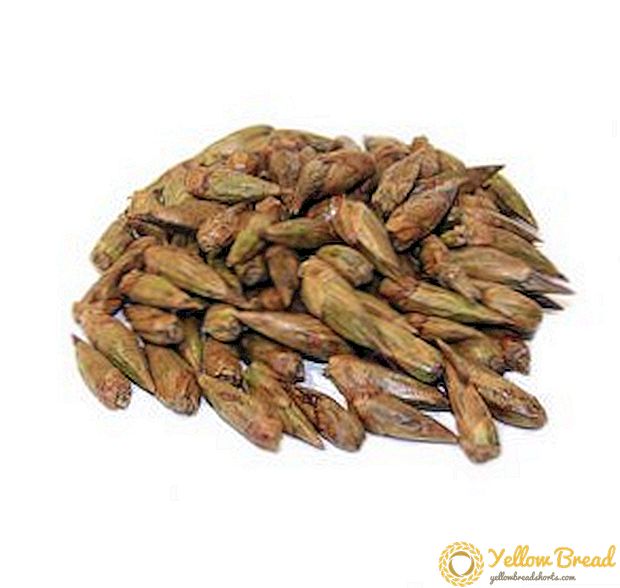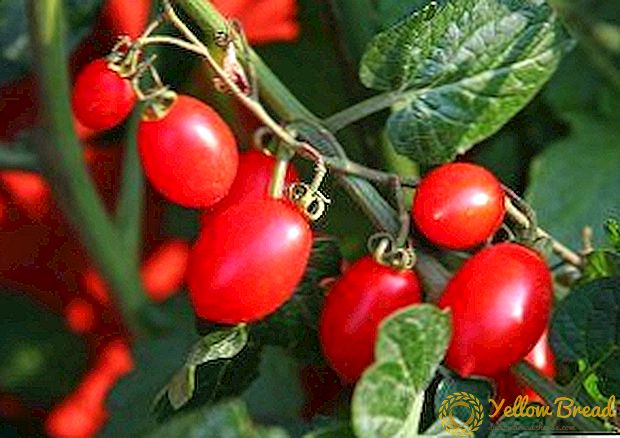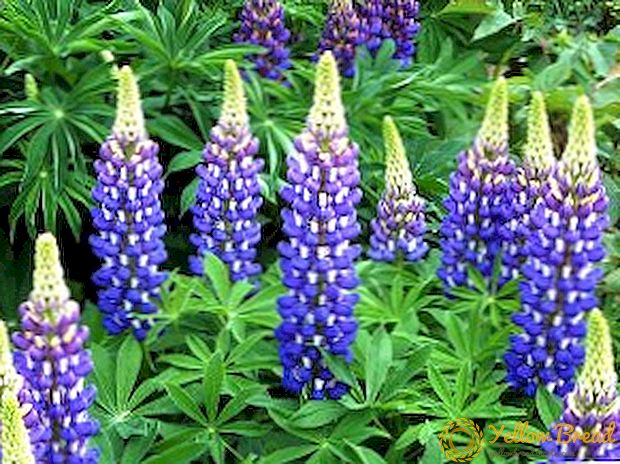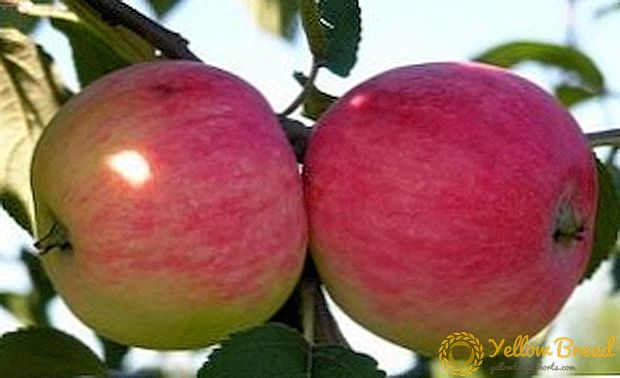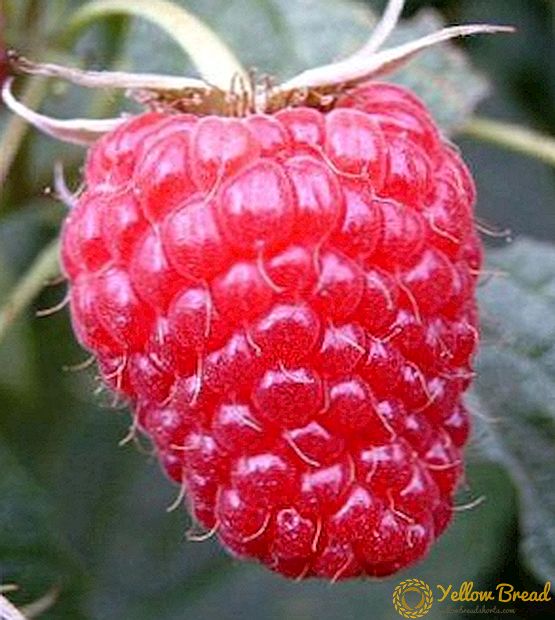 In the reviews about raspberry Brusuvian on the forums, gardeners with enthusiasm speak only about the yield and prospects of the variety, while for some reason not mentioning its shortcomings.
In the reviews about raspberry Brusuvian on the forums, gardeners with enthusiasm speak only about the yield and prospects of the variety, while for some reason not mentioning its shortcomings.
We decided to look into this by rechecking the publicized advantages of culture.
- Selection
- Description and characteristics of the variety
- Bushes
- Berries
- Yield
- Disease resistance
- Frost resistance
- What to look for when buying seedlings
- Choosing the right place
- Lighting
- The soil
- Pre-work
- Planting seedlings on the site
- Timing
- Scheme
- Seasonal care features
- Watering and mulching
- Feedings
- Preventive treatment
- Trellis
- Pruning
- Shelter for the winter
Selection
As a result of the search for truth, we found ourselves in the village of Kostovtsy, which is in the Zhytomyr region. It was there, on an area of more than 30 hectares, a huge berry nursery belonging to the company "Brusviana" was spread. The whole fields of raspberry remontant varieties that reached the horizon indicated that they know a lot about the agrotechnology of growing garden crops, their requirements and whims. And all this farm belongs to the family of Vladimir and Liliana Dmitriev, who are the founders of the same name limited liability company and raspberry variety. 
"The absence in the State Register of remontant raspberry varieties, which would be characterized by early ripening, long fruiting, excellent transportability and high-quality harvest, made me think about the breeding of domestic varieties," the owner of Brusvyan LLC recalls the initial steps in breeding.  According to him, at that time botanists of neighboring Poland and Russia could boast of such varieties, but Ukraine was lagging behind in this regard. All attempts to register the work of Russian breeders were unsuccessful. Therefore, the desperate gardener had no choice but to take on the creation of something new and promising.
According to him, at that time botanists of neighboring Poland and Russia could boast of such varieties, but Ukraine was lagging behind in this regard. All attempts to register the work of Russian breeders were unsuccessful. Therefore, the desperate gardener had no choice but to take on the creation of something new and promising.
Work on the realization of the dream began in 1993 and lasted for a long 15 years.By crossing the Polish variety Poran dew and the Russian raspberry varieties that were popular at the time, the author refined the new look to perfection. As a result, he received an early ripening crop with a smooth, not prickly, stem, large and tasty fruits that he did not leave the bush until mid-September.
In 2008, the Brusvian variety was introduced into the State Register. A year later, the company "Brusvian" registered another 4 of their creations: Brusilovskaya, Mayor, Brusilovsky standard, Yaroslavna.  Why is the breeder so important was the registration, because the demand for its products has always been. It turned out that Vladimir Dmitriev did not plan to limit himself to breeding varieties for gardeners who do not care about formalities, but rather are interested in the quality and price of the product. For them in the nursery grows many varieties that have not yet had time to register.But for industrial bookmarks, the guarantee of the percentage of germination, quality and proclaimed characteristics is just what is needed. That is what gives the registration certificate.
Why is the breeder so important was the registration, because the demand for its products has always been. It turned out that Vladimir Dmitriev did not plan to limit himself to breeding varieties for gardeners who do not care about formalities, but rather are interested in the quality and price of the product. For them in the nursery grows many varieties that have not yet had time to register.But for industrial bookmarks, the guarantee of the percentage of germination, quality and proclaimed characteristics is just what is needed. That is what gives the registration certificate.
Description and characteristics of the variety
Today, raspberry Brusviana is not just the first in the Ukrainian breeding remontant variety, but also a leader in many agrotechnical characteristics. Let us consider in more detail what the variety has earned the attention of professional and beginner gardeners.
Bushes
A specific feature of Brusvians breeders Dmitrievs call shoots resistance to lodging. The plant is distinguished by the density of its inflorescences and under the weight of mature fruits it does not bend or break. Also of interest is the smooth surface of the stems, which facilitates harvesting. The branches develop upwards and reach a height of two meters. Sometimes it can stretch much higher. Despite their impressive thickness, it is still recommended to install supports under tree bushes. 
Berries
The first ripe berries of this raspberry variety can be tasted as early as the second decade of June. A subsequent wave of fruiting yields a harvest in August. Fruits differ from their counterparts in large size and impeccable taste. In fact, it is the largest berries of all known now raspberry varieties. Each weighs at least 15 g. In the inflorescences they look great, densely covering two-thirds of the stem.  Consumers say only good about the harvest of Brusvians. In fact, there is a great sweet and sour taste, high product quality and elasticity of fruits. Thanks to these characteristics, cooks share excellent jam recipes, in which the berry does not lose its shape, even after a long thermal treatment.
Consumers say only good about the harvest of Brusvians. In fact, there is a great sweet and sour taste, high product quality and elasticity of fruits. Thanks to these characteristics, cooks share excellent jam recipes, in which the berry does not lose its shape, even after a long thermal treatment.
Yield
Brusvyan fruits twice a year. It is this quality that attracts gardeners. In addition, raspberries are characterized by high yields. With one adult bush owners collect from 4 to 8 kg of berries.The last figure is possible when installing drip irrigation and proper care of the berry. The attractive appearance of the fruit and taste allow you to engage in the berry industry for commercial purposes.
Disease resistance
In some sources there is information about the extreme endurance of the variety in front of attacks of pathogens, fungi and pests. In fact, the bush really has a genetic resistance to common diseases of berry crops. But this feature of the plant at the level of standard assortment. 
Frost resistance
Without exaggeration, gardeners say about the high endurance of the plant to low temperatures. Raspberries winter well even at -30 ° C and snowless winters.
What to look for when buying seedlings
Growing Brusovyan's raspberry pick depends on the quality of the seed. From a healthy seedling a strong bush with high rates of fruiting will be formed very quickly.Therefore, when choosing a seedling, you need to carefully examine the instance you like, check for the freshness of its roots, and only after making sure that all the parts of the plant meet your requirements, you can make a purchase.
Experts advise to give preference to saplings with a strong, well-branched root system and strong, thick shoots. Scrape any root process with your fingernail. The fresh wood that appeared on the site of the damage indicates that the bush has recently been dug out and its roots are suitable for planting. If instead you find darkened rotten or moldy areas, dry, broken roots - it is better to find another seedling.  A good shrub must have holistic and viable stems with a uniform surface. It is desirable that among them was at least one lignified specimen. His presence ensures quick survival and easy wintering of a young plant. In the presence of galls, spotting and any damage to the shoots from the purchase is better to refuse.
A good shrub must have holistic and viable stems with a uniform surface. It is desirable that among them was at least one lignified specimen. His presence ensures quick survival and easy wintering of a young plant. In the presence of galls, spotting and any damage to the shoots from the purchase is better to refuse.
Choosing the right place
Many beginning gardeners mistakenly perceive remontant raspberry varieties as super-durable and do not give Brusvians the necessary attention in planting and care. In the end, get a bad harvest or dead cuttings. In order not to waste money and time on laying the berry, do not be lazy to find the right site for it. In this case, special attention should be paid to lighting and soil features. We will understand everything in order.
Lighting
All raspberries prefer sunny areas, protected from winds, cold air and excess moisture. Bushes develop much better under ultraviolet light, their shoots are not stretched and are characterized by power. For Brusvians, this nuance is extremely important, because the shoots must withstand the burden of the future harvest.  In addition, the berries in the sun are filled with sugar content, and their flavor becomes more pronounced. In the dark, such an effect cannot be achieved. Moreover, the berries will be different sour, less pleasant taste.The abundance of heat and light of this variety raspberries are not terrible, even with prolonged sunshine. Berries practically do not bake under the hot sun and do not lose their juiciness.
In addition, the berries in the sun are filled with sugar content, and their flavor becomes more pronounced. In the dark, such an effect cannot be achieved. Moreover, the berries will be different sour, less pleasant taste.The abundance of heat and light of this variety raspberries are not terrible, even with prolonged sunshine. Berries practically do not bake under the hot sun and do not lose their juiciness.
The soil
For a hybrid, nutrient availability and good drainage are important. Therefore, an ideal option for planting raspberries would be a terrain that is characterized by light fertile substrates with neutral acidity. If you don’t find such a site in your garden, experts advise to make a soil adjustment by adding missing elements and known alkalization.
Pre-work
When to start preplant preparation in raspberry jam depends on the period of rooting of seedlings. If it is carried out in the spring, then it is necessary to prepare the site in the fall. In the case of autumn planting, it is advisable to deploy preparatory activities in the front garden at least a month before.
Preparation consists in thoroughly digging the terrain to a depth of at least 30 cm and applying fertilizer to the soil. Under the bushes that are planned for planting in April, it is recommended to bring superphosphate and potash components (respectively, the calculation of 50 g and 40 g per square meter of area). But for the autumn planting will be useful organic matter - humus, a solution of infusion of chicken manure and compost. 
In the oxidized areas, experts advise to make a well-known fuzz, dolomite flour, cement dust or ordinary old plaster. Depending on the level of acidity, a standard unit of area will require from 150 to 300 g of substance. Also, wood ash will not be superfluous in the substrate.
Planting material is also subject to preplant preparation. Its tops are cut at a level of 15-20 cm from the ground, and the roots are dipped into a clay mash. These manipulations will protect plants from weathering drying and contribute to its fertility.
Planting seedlings on the site
Choosing a healthy seedling of a promising remontant variety and preparing the right plot for planting is only half of the guaranteed success in growing raspberries. Of particular importance is the process of rooting bushes, as well as its timing.
Timing
Most gardeners consider the period starting from the second decade of April to be ideal dates for planting raspberry bushes. Then it is already quite warm outside, and the earth has warmed to stable + 15 ° С. Under such conditions, the risks of root rot and fungal infections are low. But along with the positive moments, the possibility of drying the root system is noted.
Spring planting allows the plants to quickly take root and build up to the fall of a strong, well-developed rhizome. Such instances are easier to tolerate the winter, because, despite the genetic resistance of the culture to the cold, young saplings need additional preparation for wintering.  Allowed to plant raspberries in the fall. As a rule, this process is planned in the first weeks of October, when the heat in the street was asleep, but it was not yet frozen. It is important to have time to reduce the temperature, because the roots need at least 2 weeks to adapt.
Allowed to plant raspberries in the fall. As a rule, this process is planned in the first weeks of October, when the heat in the street was asleep, but it was not yet frozen. It is important to have time to reduce the temperature, because the roots need at least 2 weeks to adapt.
Scheme
In close berry, even the most productive variety will not be pleased with abundant fruiting. For the full development of the bushes need space. That is why experts do not recommend zagushchat landing. The optimum distance between Brusvian plants is within the limits of 70-100 cm with trenching technology of raspberry growing and 1.5 m with cluster.
Do not save on the spacing, because the variety is considered tall with abundant shoots and powerful shoots. In the cramped, first, in the berrypipe pipe work. And, secondly, the branches to the best of their development will create a shadow for each other, hindering the development.
Amateur gardeners are recommended to plant raspberry bushes, leaving up to 1 m between plants and up to 2 m between rows. On a hundred square meters, this scheme allows you to place about 90 seedlings. 
Seasonal care features
Raspberry is a very profitable commercial offer. From the point of view of market analysts, the demand for berries is growing, which allows you to keep good product prices. And from the point of view of gardeners, the culture does not require large financial expenditures and labor resources involved. In order to harvest good harvests from the plantation, it is enough to ensure timely irrigation and fertilizing for the bushes, as well as the competent pruning and care of the soil. We will understand in more detail in these nuances.
Watering and mulching
A specific and very important feature of Brusvians is its intolerance to dryness and excessive moisture. For a hybrid, it is important that there is a moderate amount of water in the substrate.
Many progressive gardeners do not make themselves heavy with bucket irrigation and install drip devices. This way of moisturizing the berries is just perfect for remontant varieties of culture. Experts advise weekly in the evenings for no more than 2 hours to include the installation for wetting the berries.It should focus on the condition of the soil. If it is wet, the procedure should be postponed.  In the drought on the bushes can get tired and even fall off the foliage. Therefore, it makes sense to look at the state of the plants. If you overwhelm the roots too, mold spots and fungal infections can occur in the root part of the stem, which spread to all plants very quickly.
In the drought on the bushes can get tired and even fall off the foliage. Therefore, it makes sense to look at the state of the plants. If you overwhelm the roots too, mold spots and fungal infections can occur in the root part of the stem, which spread to all plants very quickly.
To protect the bushes from drying out, be sure to mulch the berries. For these purposes, professionals recommend the use of dry grass, humus or peat.
Feedings
So that the plant does not deplete the soil and does not experience a shortage of nutrients, it must be fertilized every spring. When vegetation begins, organic matter is introduced under the roots. This may not be a highly concentrated solution of chicken manure or cow dung (1:10). Also at this stage of development of bushes granular ammonium sulfate is relevant. Dry matter is simply sprinkled in tree circles before rain or watering.
The next portion of fertilizer in the berry contribute in the fall, when it is important to harden the culture before the cold.Nitrogenous substances are strictly contraindicated during this period, since they contribute to the formation of new shoots that they will not have time to woody and get stronger before frost. In order to stimulate the frost resistance of raspberries, experienced gardeners advise to add potassium sulphide to the soil.
Preventive treatment
Specialists rated the resistance of the hybrid to typical berry diseases and pests as average. The variety is no exception and, like other raspberry varieties, is susceptible to rust, blotchiness, chlorosis, anthracnose and root cancer. In addition, the bushes attract weevils, ants and raspberry beetles. It is necessary to get rid of all this insect and microbial management in advance, before the first symptoms appear.  In order to prevent fungal and bacterial diseases, it is important in the beginning of spring to spray the plantation with fungicides (Skor, Fundazol, Maxim) or with a Bordeaux mixture, copper vitriol.If large foci of infection are noticeable on the plants, immediately cut out all the affected stalks and burn them, and disinfect the front garden with the above-mentioned toxic chemicals.
In order to prevent fungal and bacterial diseases, it is important in the beginning of spring to spray the plantation with fungicides (Skor, Fundazol, Maxim) or with a Bordeaux mixture, copper vitriol.If large foci of infection are noticeable on the plants, immediately cut out all the affected stalks and burn them, and disinfect the front garden with the above-mentioned toxic chemicals.
The use of any insecticide ("Aktara", "Aktellik", "Bi - 58 New", "Detoyl") will save a parasitic pest from a crimson plant. But even having acquired the richest arsenals of chemical agents for combating insects, bacteria and fungal spores, do not forget about competent care for the berry. After all, this is the best prevention for all plants in the garden. Remember that problems begin if there is acidic or heavily flooded soil in the area, weeds are rampant and nutrients are not entering the ground.
Trellis
Considering the tallness and branching of the hybrid bushes, it is better not to rely on the strength of the plant stem and build a special support during the planting of the bushes. It is set at a distance of two-meter stick of metal or wood, between which is a transversely stretched wire or twine. For Brusvyny, a three-row waist will suffice.  The width of the row should correspond to the height of the poles, so as not to create additional shadow for the neighboring bushes. When choosing materials for a trellis, you can use any configuration of the structure: T-shaped, V-shaped. Tie the stems to the support is recommended by wire or cloth tape.
The width of the row should correspond to the height of the poles, so as not to create additional shadow for the neighboring bushes. When choosing materials for a trellis, you can use any configuration of the structure: T-shaped, V-shaped. Tie the stems to the support is recommended by wire or cloth tape.
Pruning
When caring for the raspberry variety Brusvyan, special attention should be paid to pruning bushes. In the spring, it consists of removing dry, broken, old, and dead branches. In the summer, in order to control root growth, it is also worth looking into the front garden with scissors. After all, an aggressive culture will grow greatly and in the thickening process it will significantly reduce the yield. Some gardeners form bushes by pinching a top growing point. In fact, this method contributes to strong branching, which in turn leads to shallowing of the fruit. 
In the autumn, after harvesting the berries, all the sprouts on the bushes need to be cut, leaving 3 cm from the ground. After that, be sure to remove fallen leaves and debris from the area and apply mineral complex fertilizers labeled "autumn." On copies of the two-year cycle in November, the fruiting tops are removed and sanitary pruning is carried out.
Shelter for the winter
Although Brusvian has a high level of winter hardiness, young plants need additional preparation for the cold. After cutting such specimens, it is imperative to cover with agrofibre, and above it also with lapnik. Some owners are costing a thickened layer of peat-humus mulch. It is desirable that the flooring was not lower than 10 cm. And as soon as the threat of severe frosts has passed, it is important to remove all the structures in time so that the culture does not die from excessive heat.  During the period of its nearly ten-year existence, the hybrid of the Brusvian variety has collected only positive feedback from consumers. And, to our surprise, they are not at all exaggerated by merchants for the purpose of marketing products.
During the period of its nearly ten-year existence, the hybrid of the Brusvian variety has collected only positive feedback from consumers. And, to our surprise, they are not at all exaggerated by merchants for the purpose of marketing products.
In fact, we were convinced of the competitiveness and potential of the described variety. Of course, it is not perfect. One does not like the lack of a glossy glare on the berries, others complain about the need for tying bushes. But these little things compared to the merits of the species is almost not noticeable. Brusvian is somewhat inferior to certain industrial giants, but in terms of taste and commodity qualities of berries, it even looks advantageous to the selection properties of neighboring states. 

